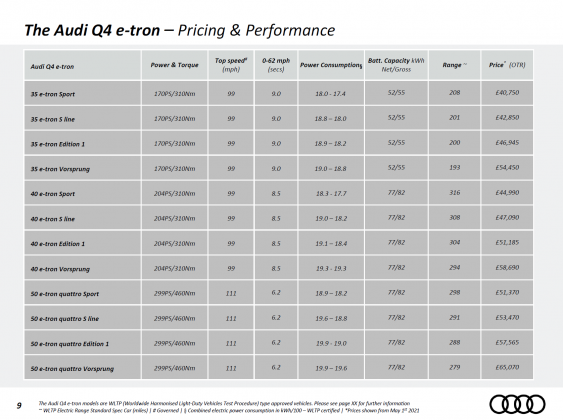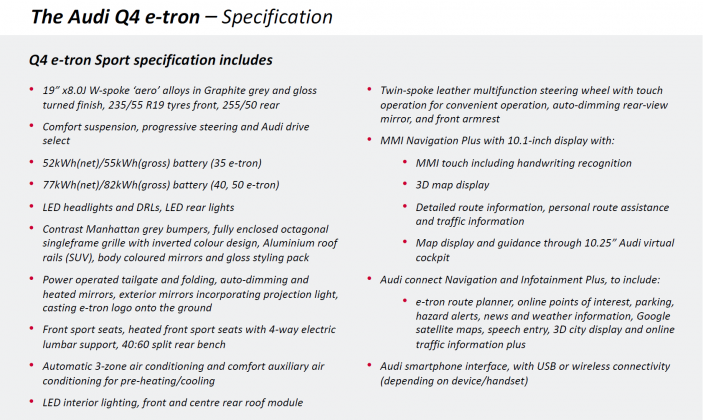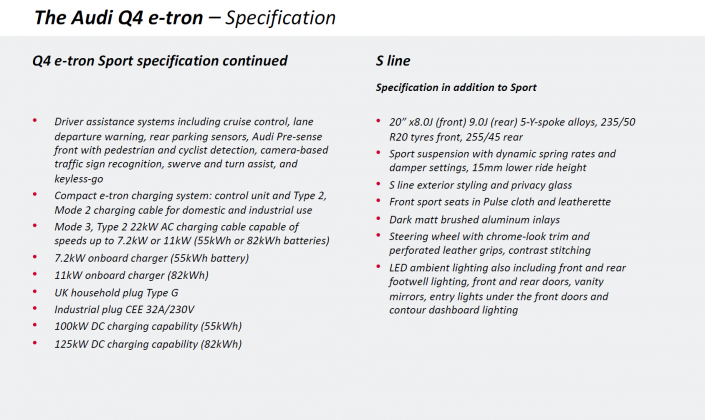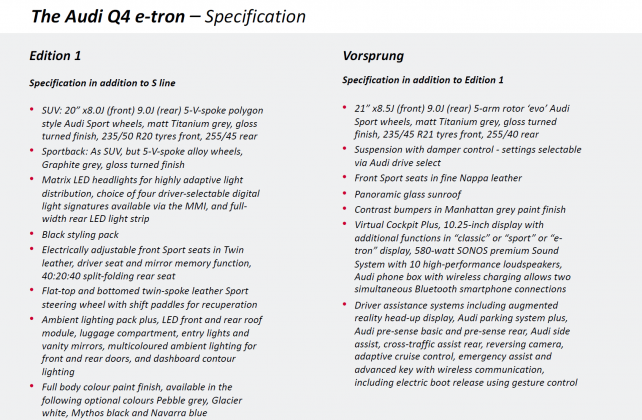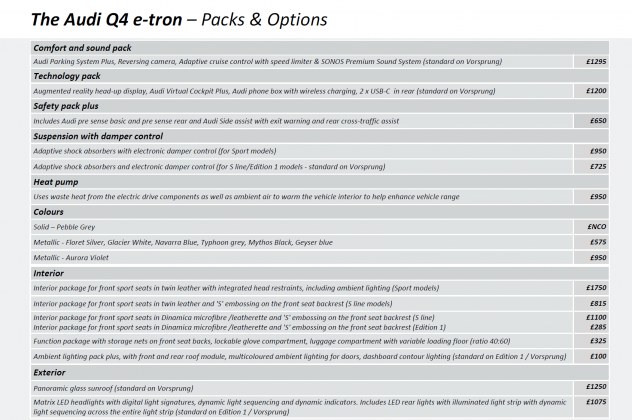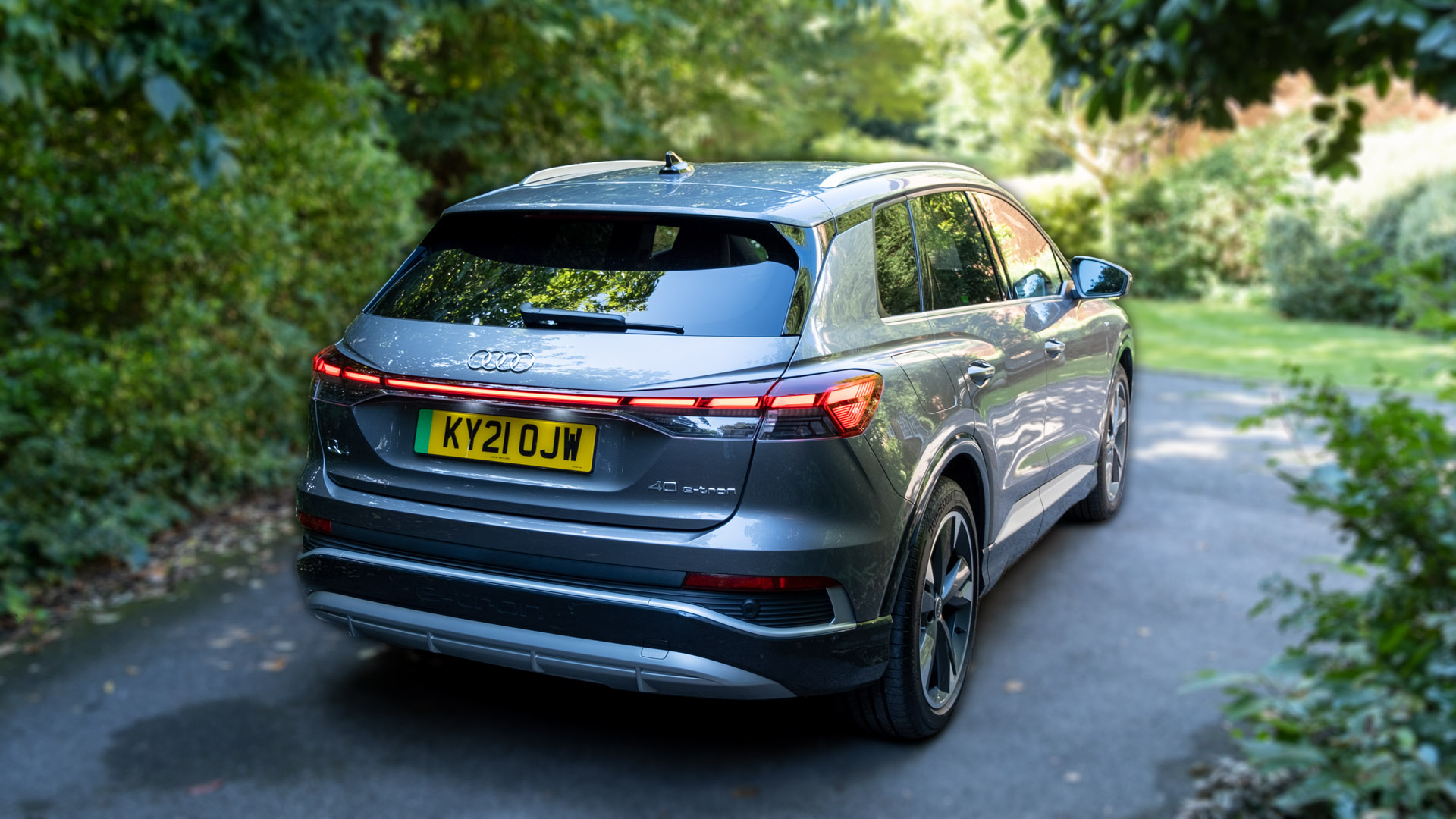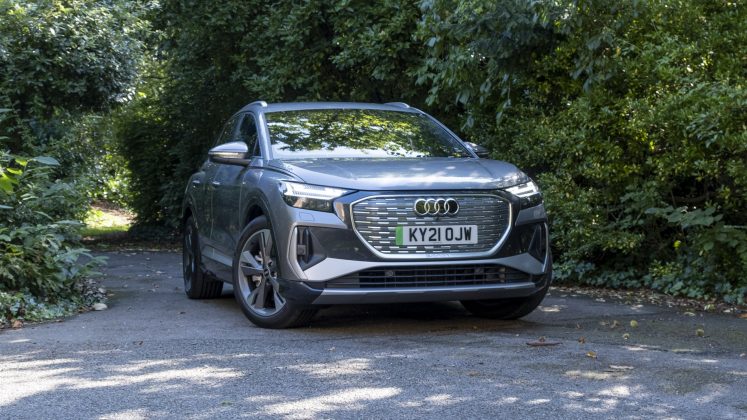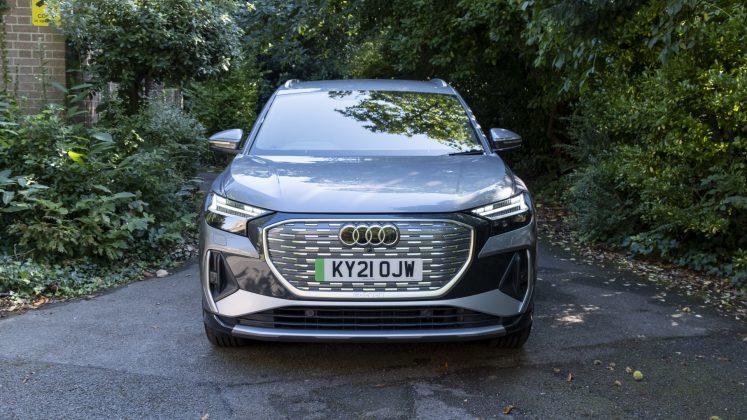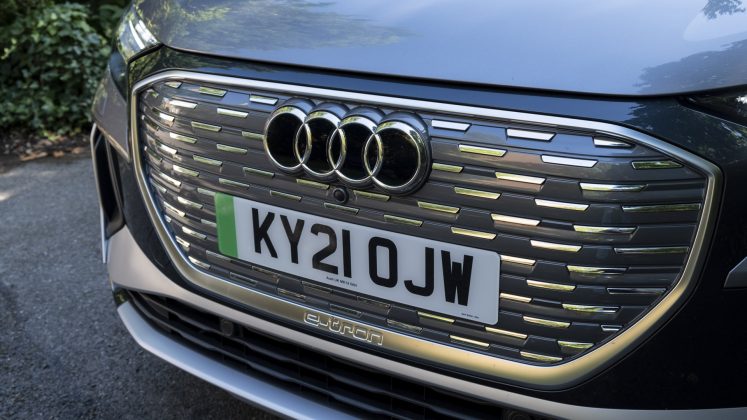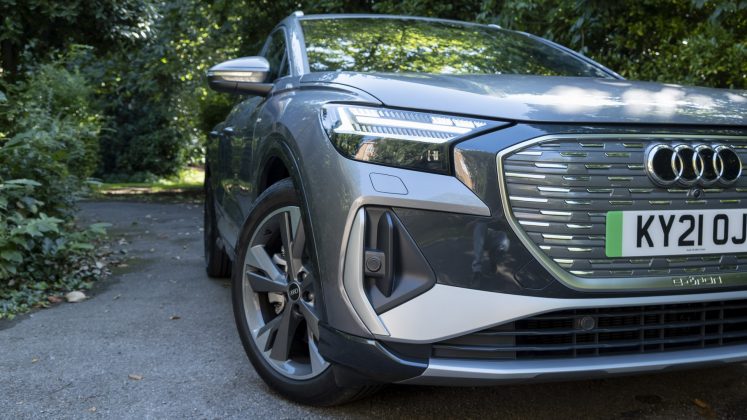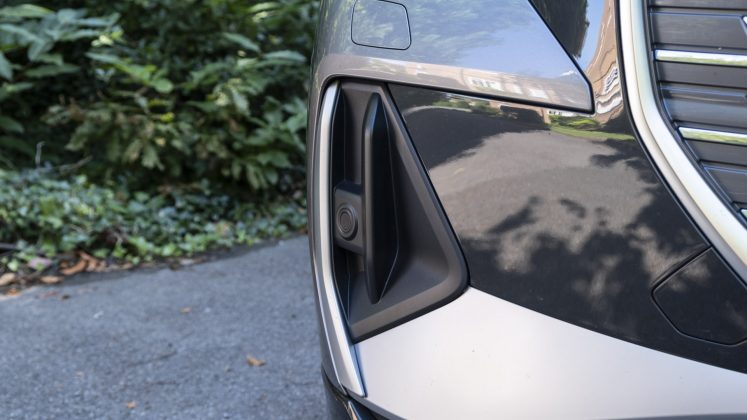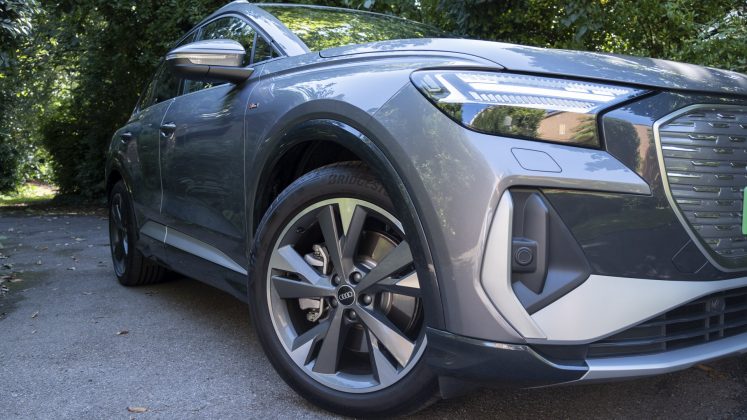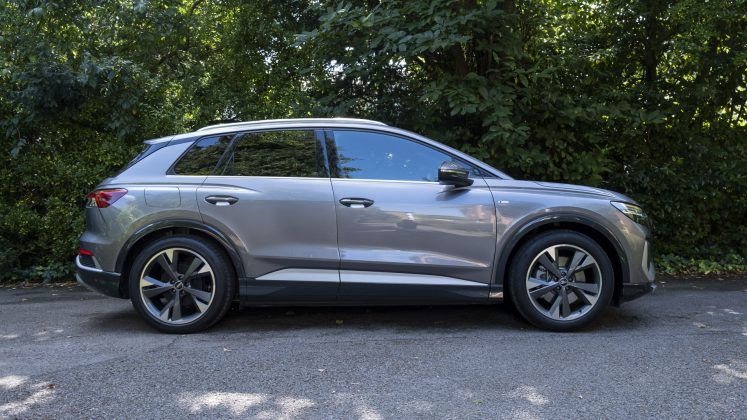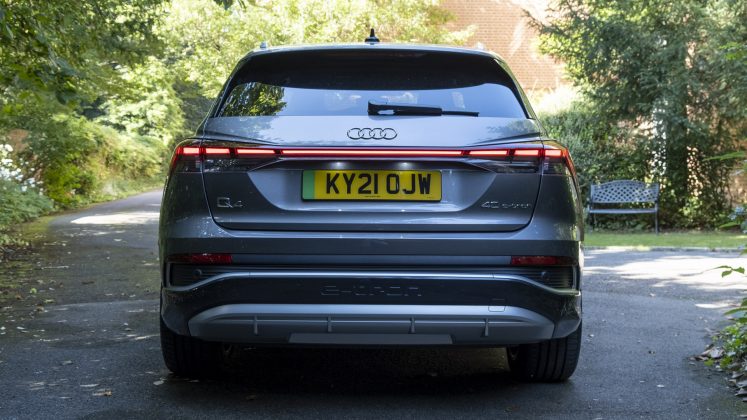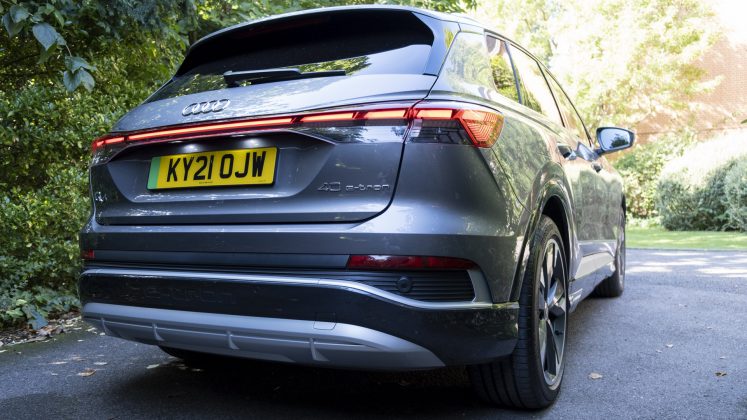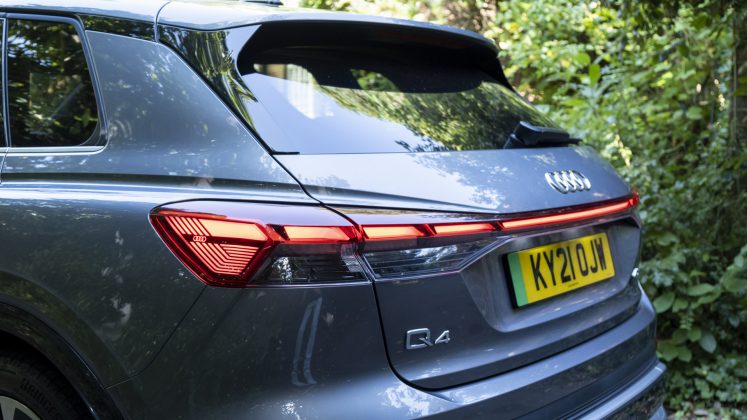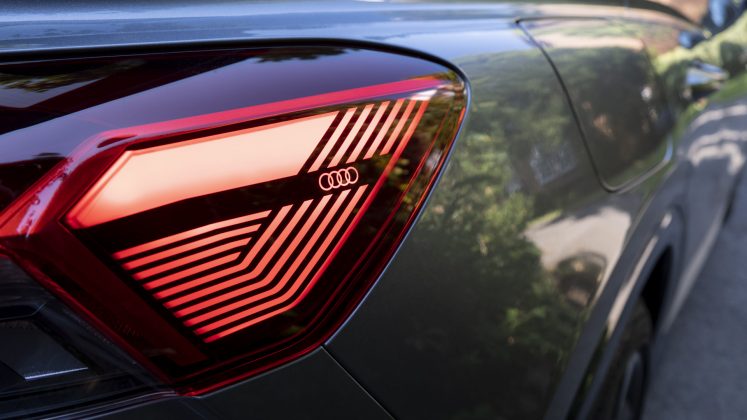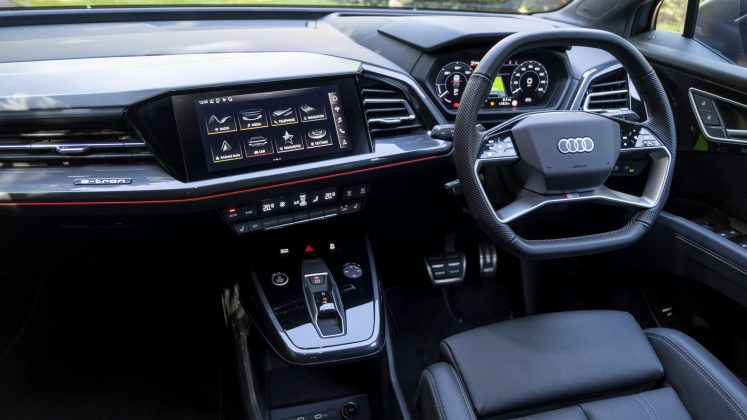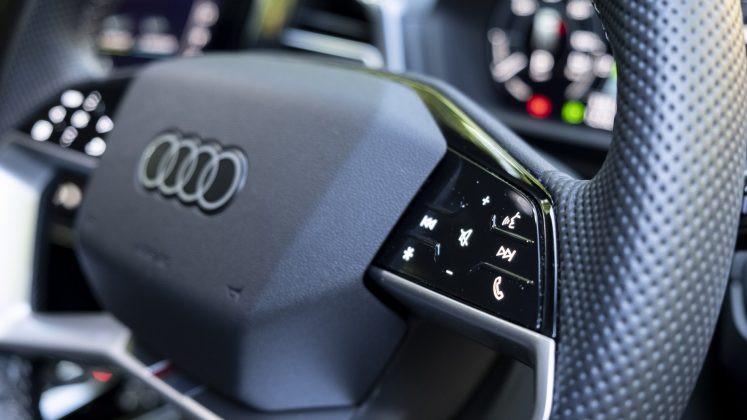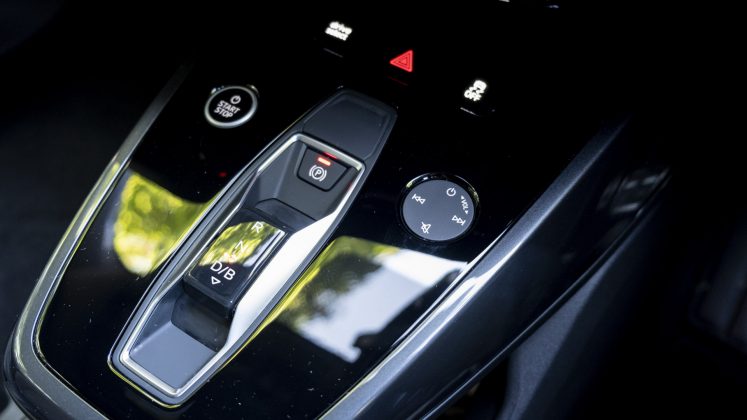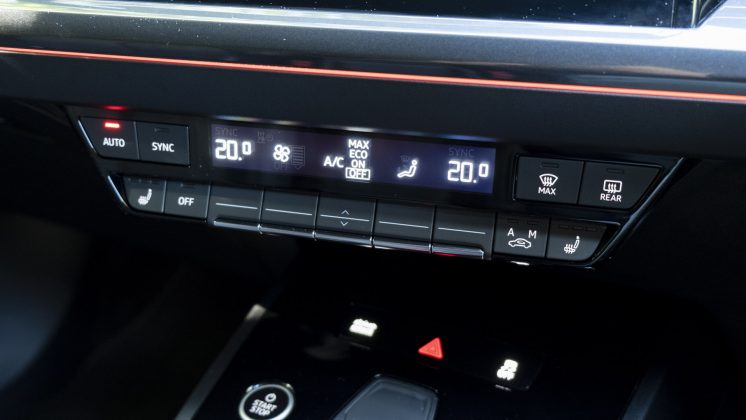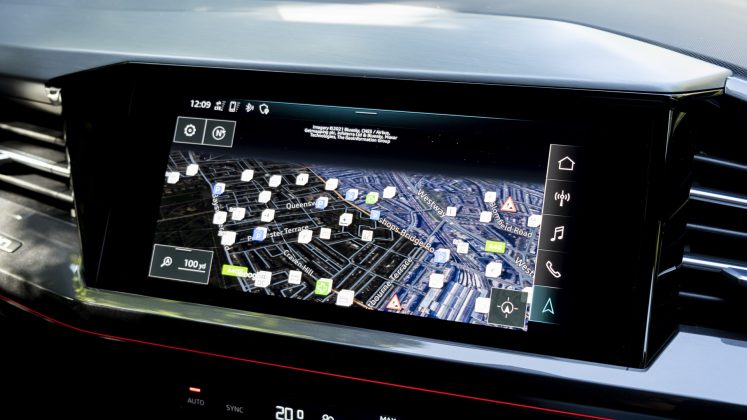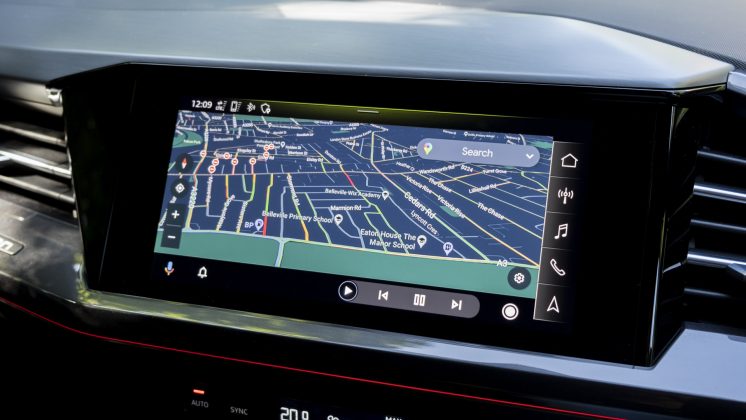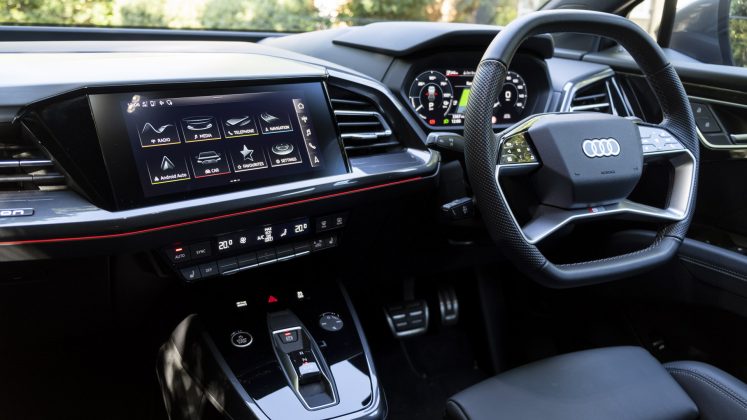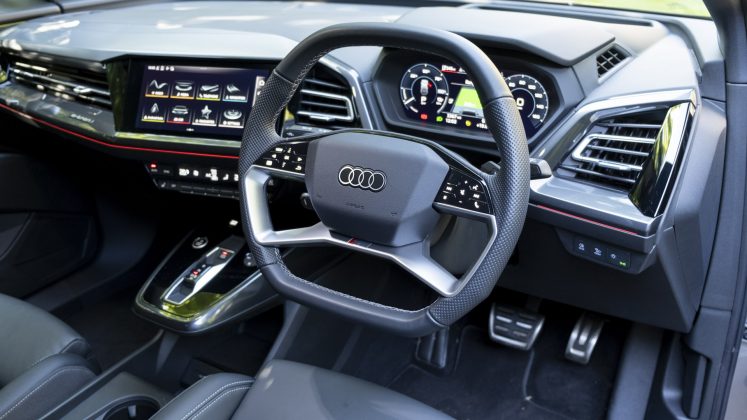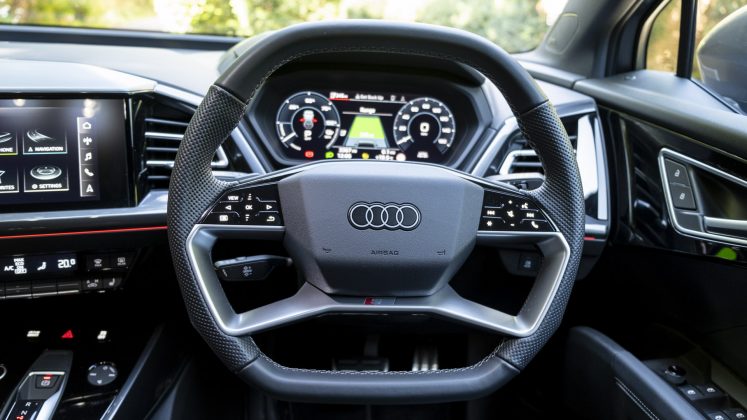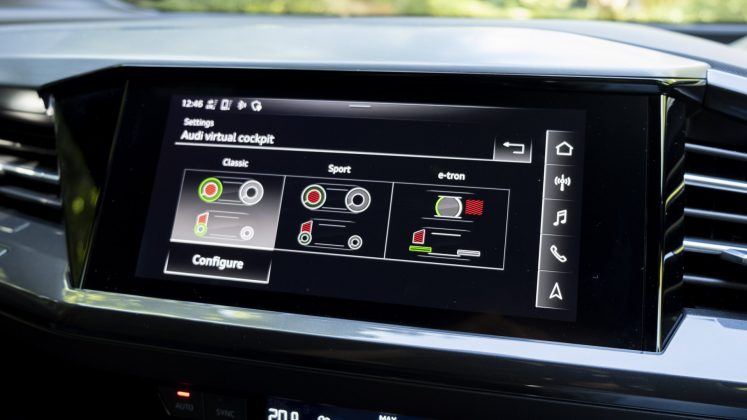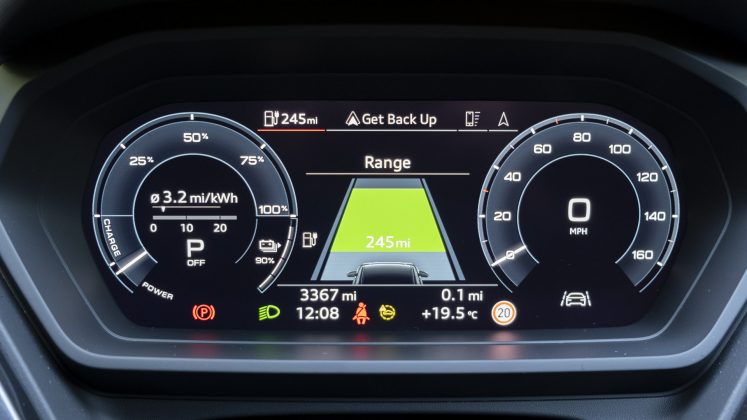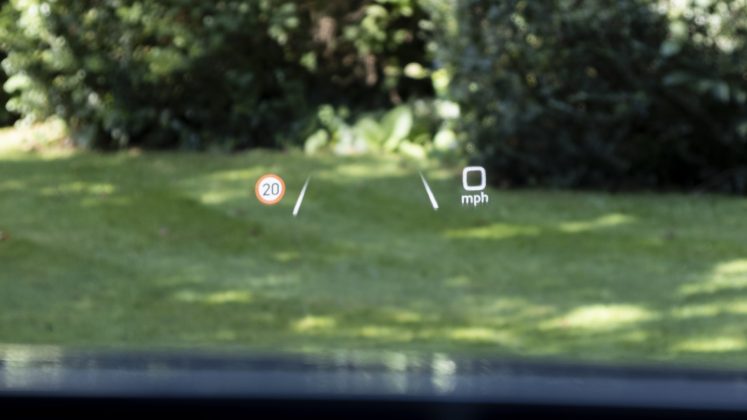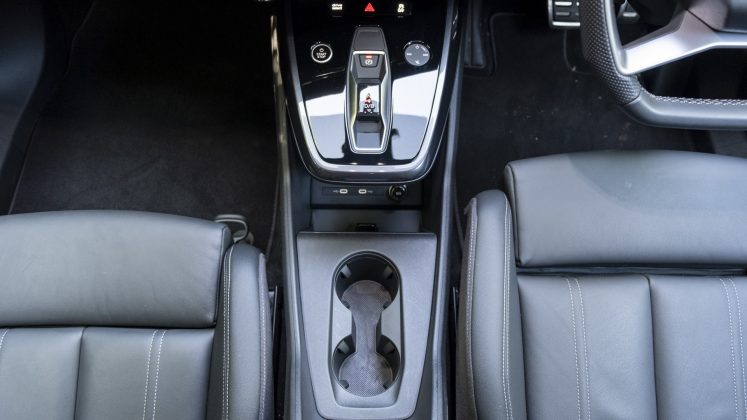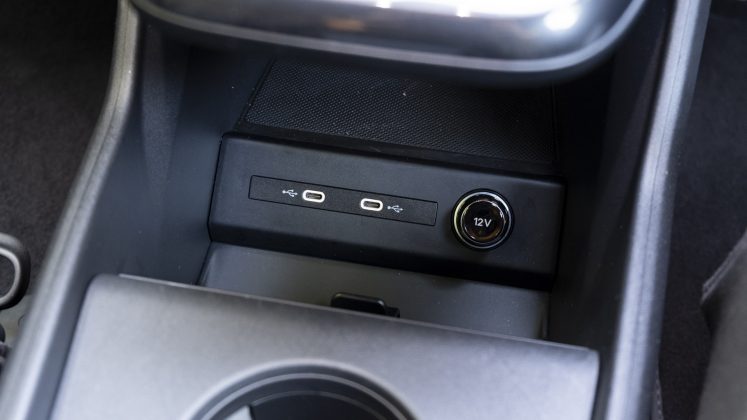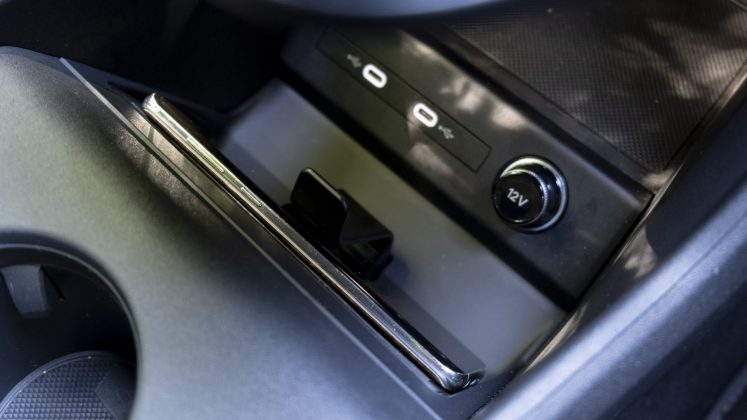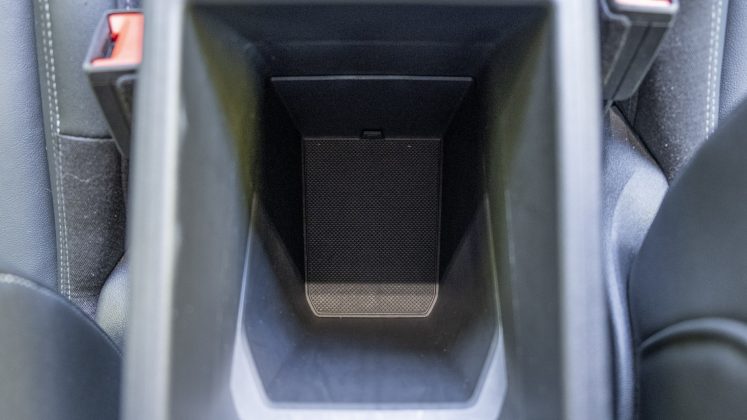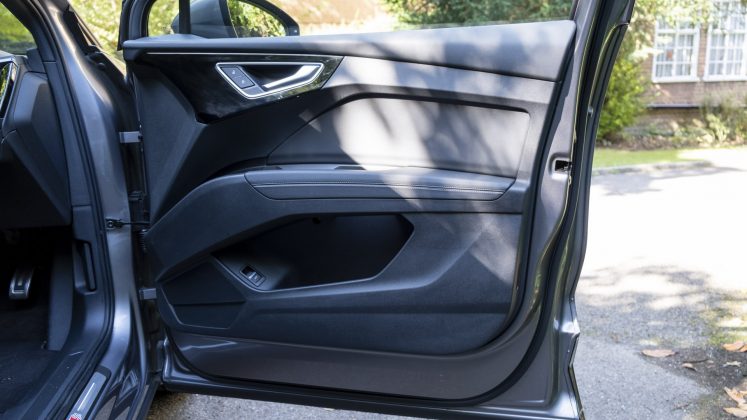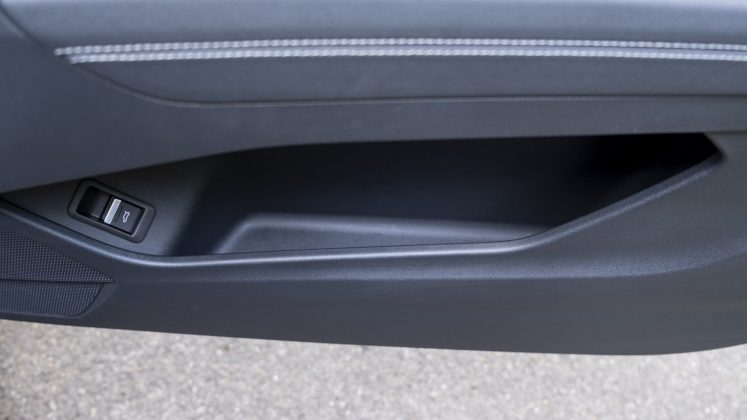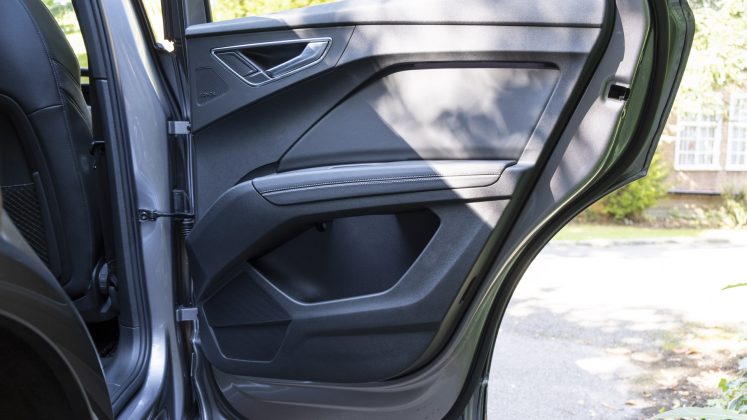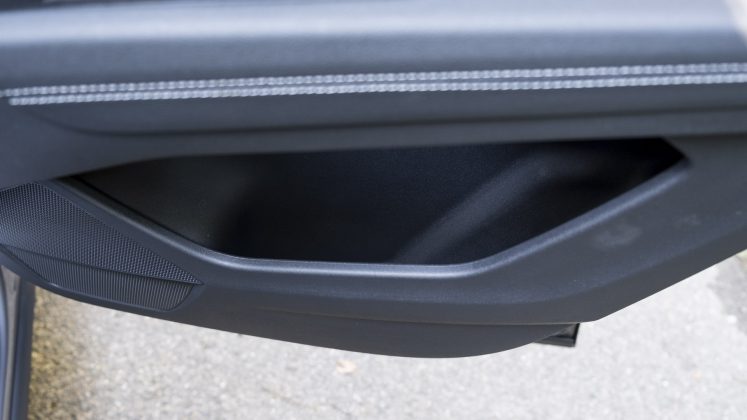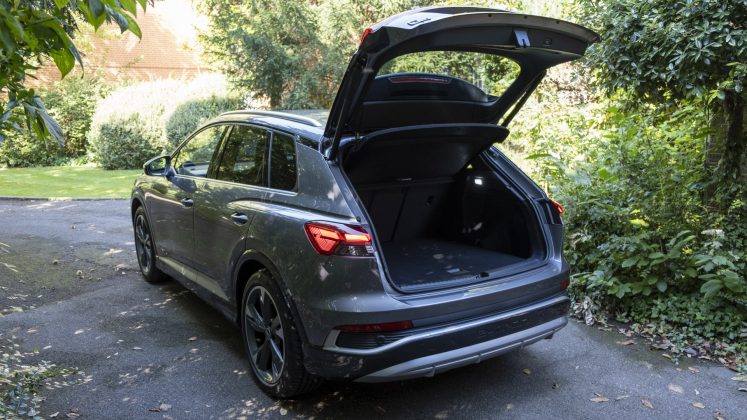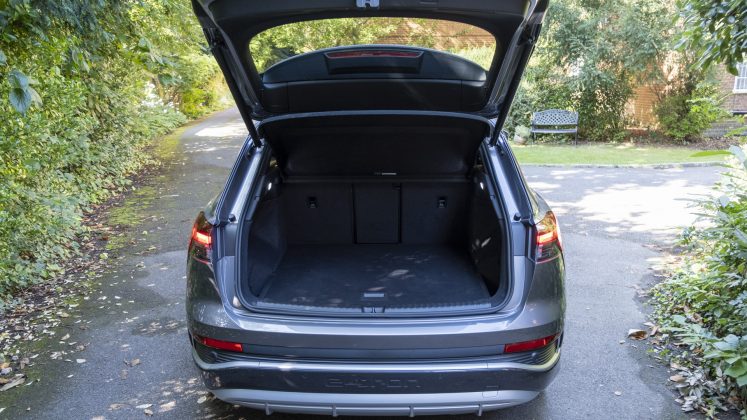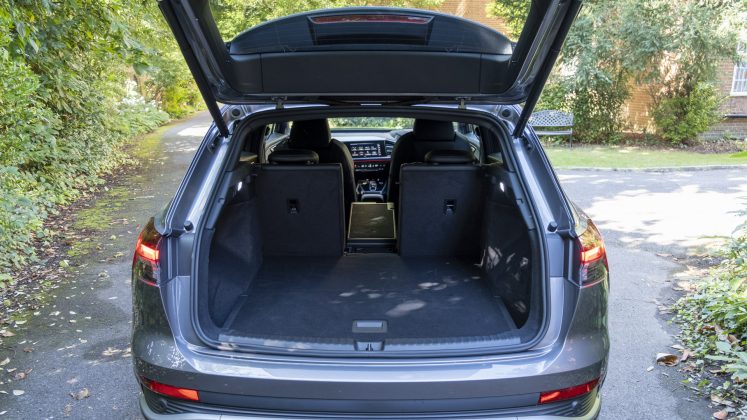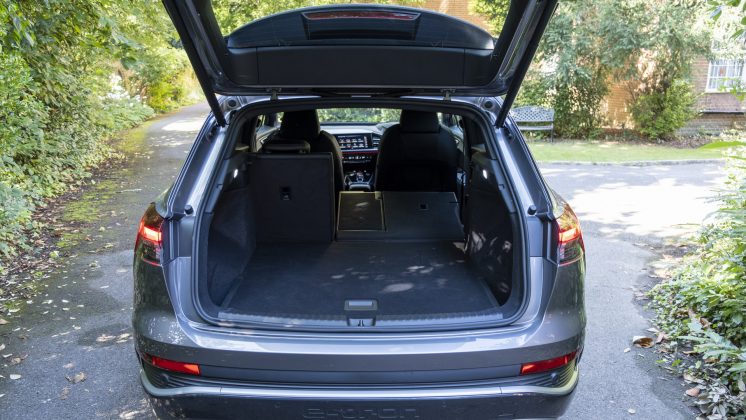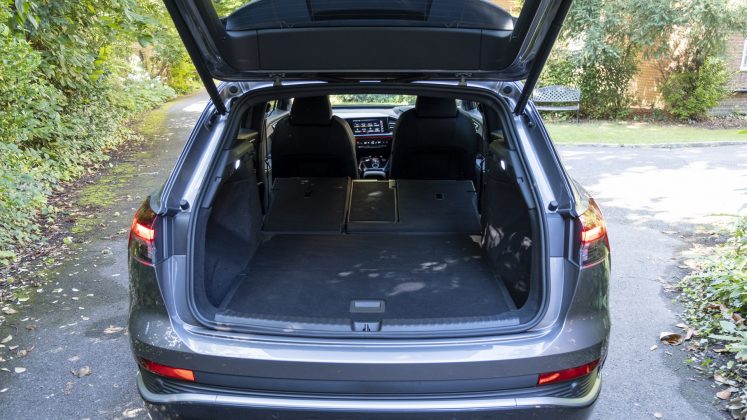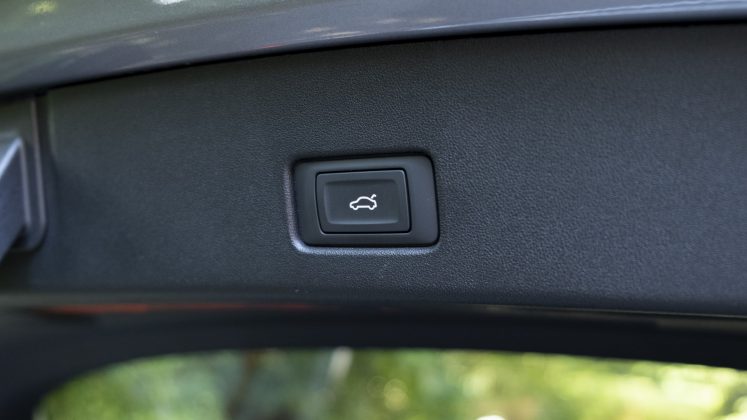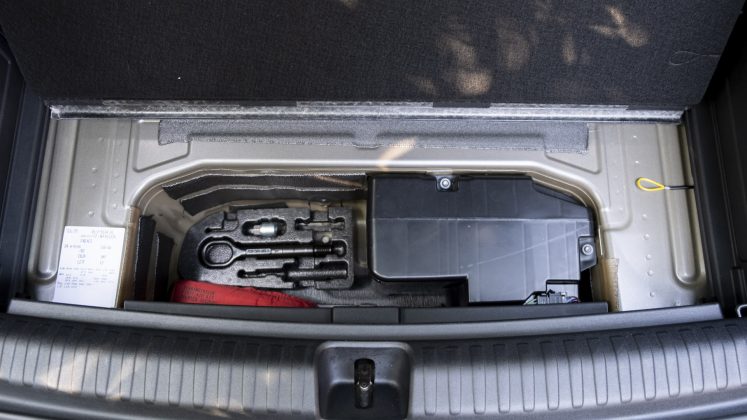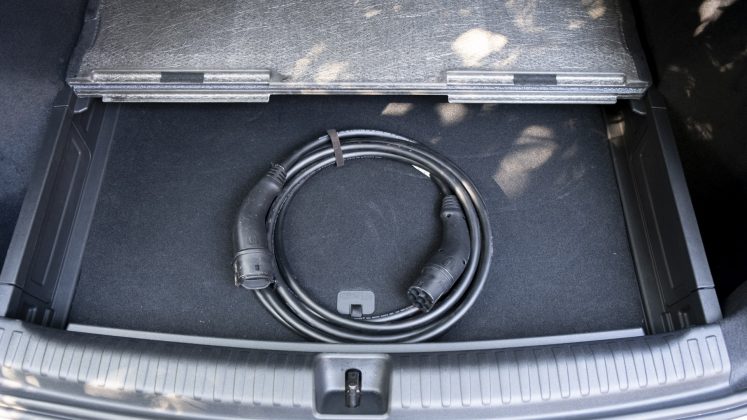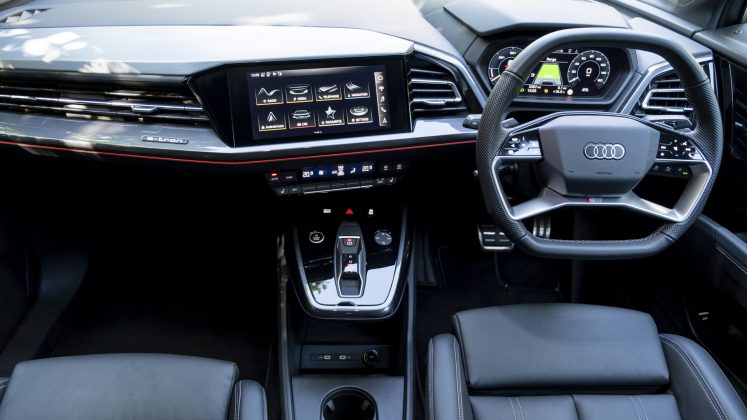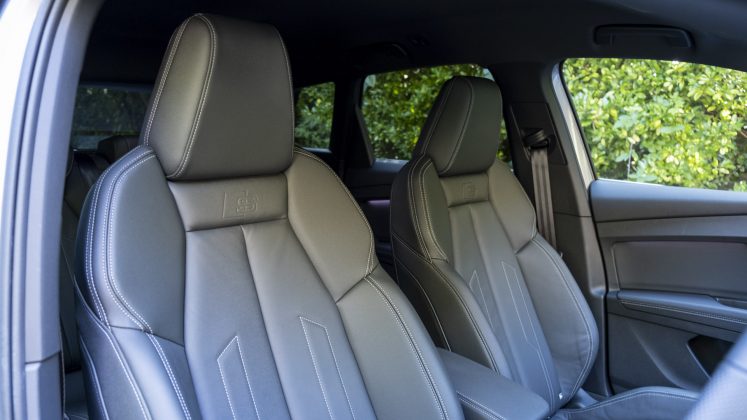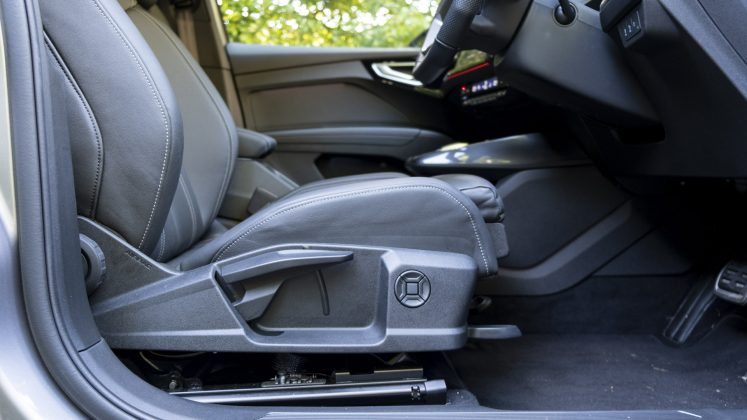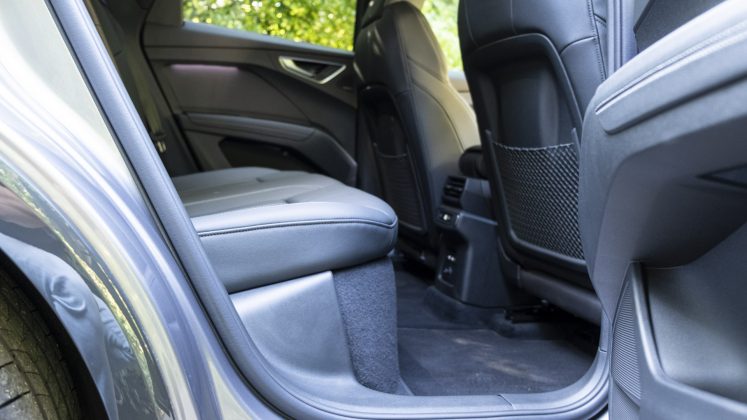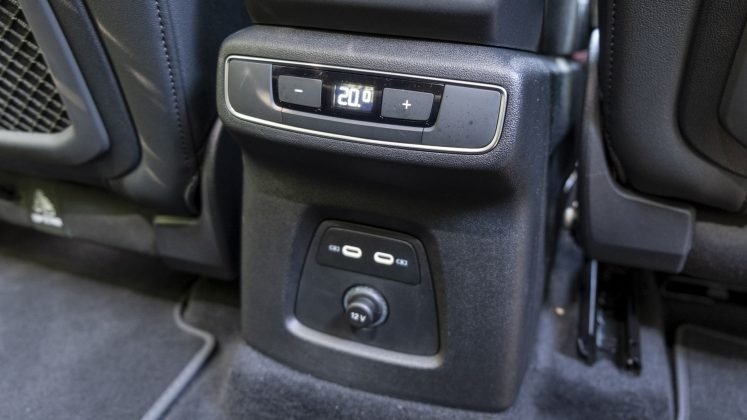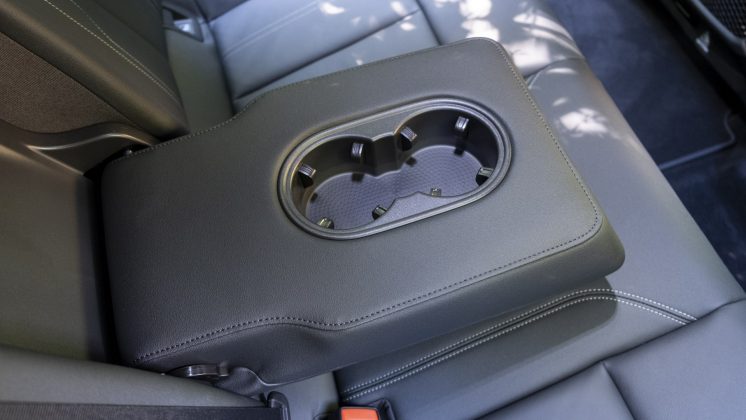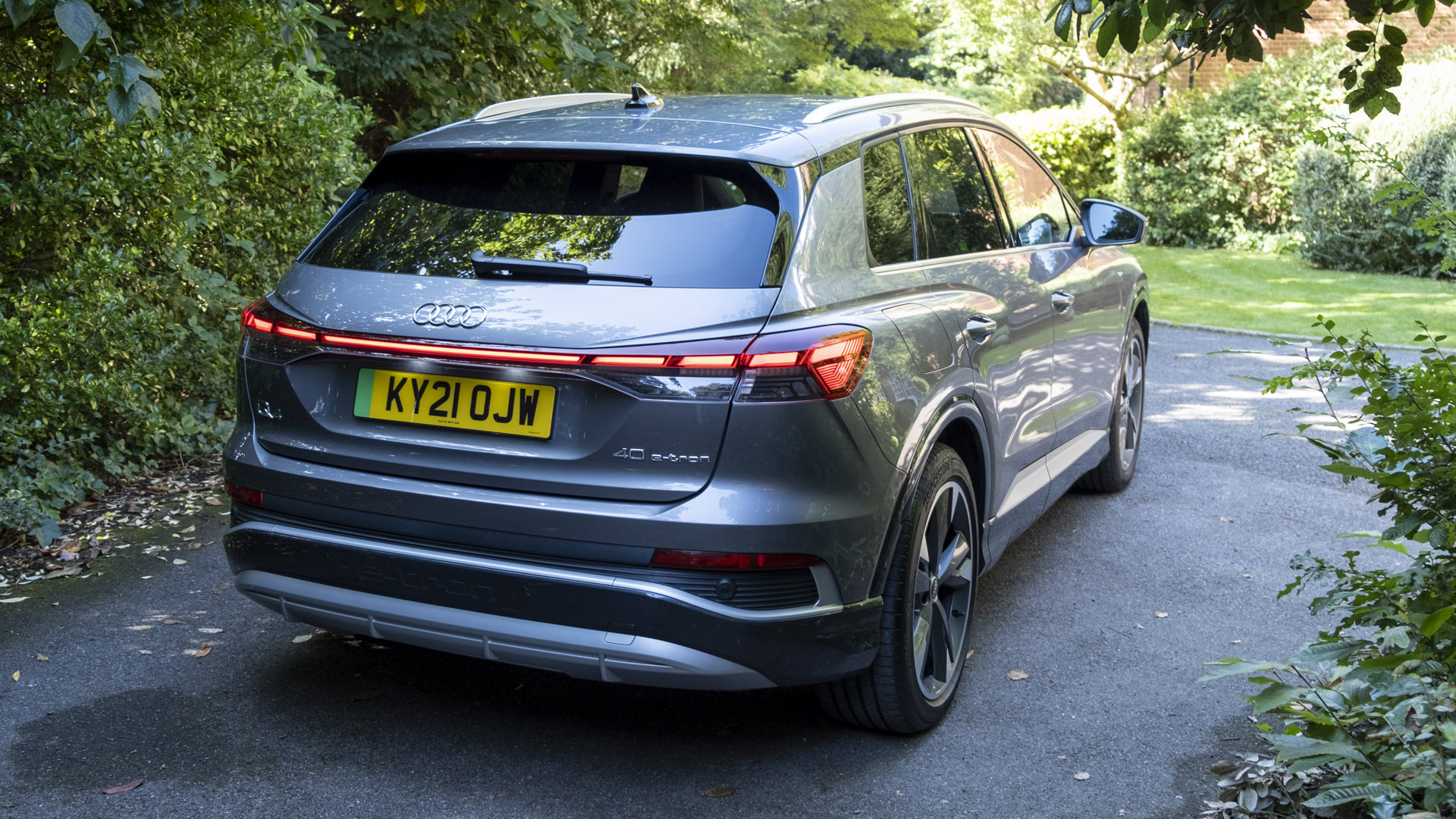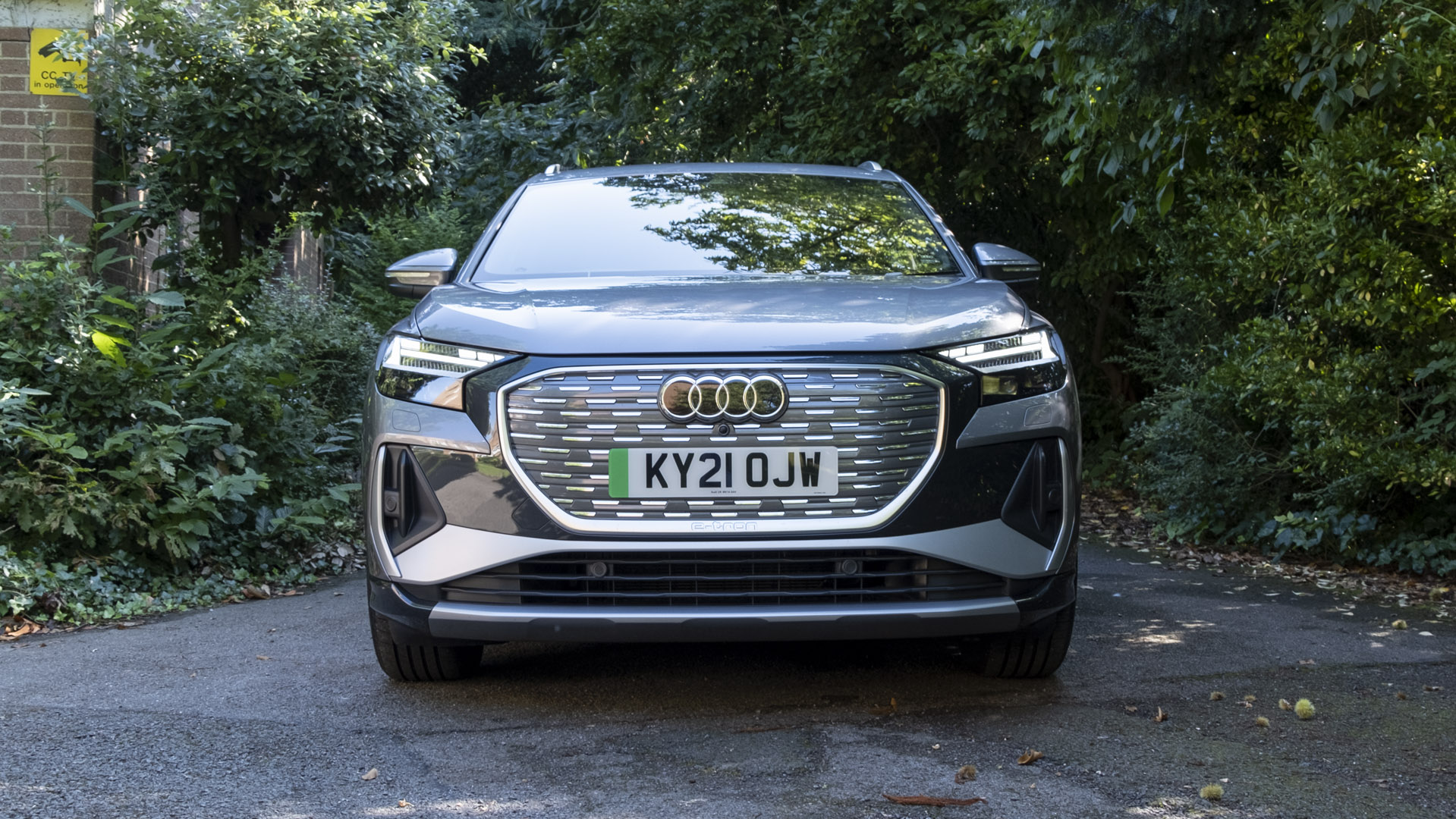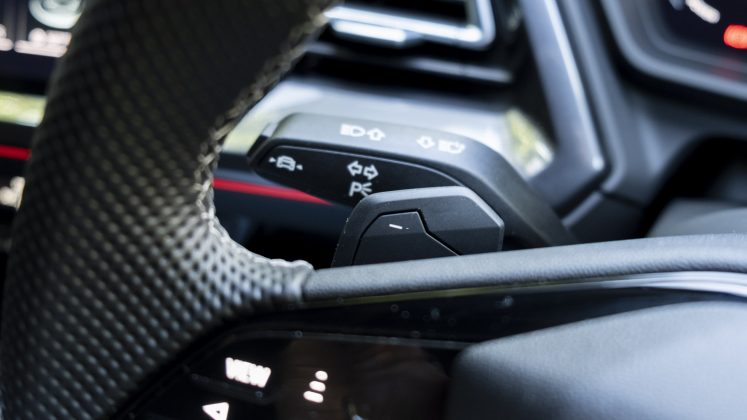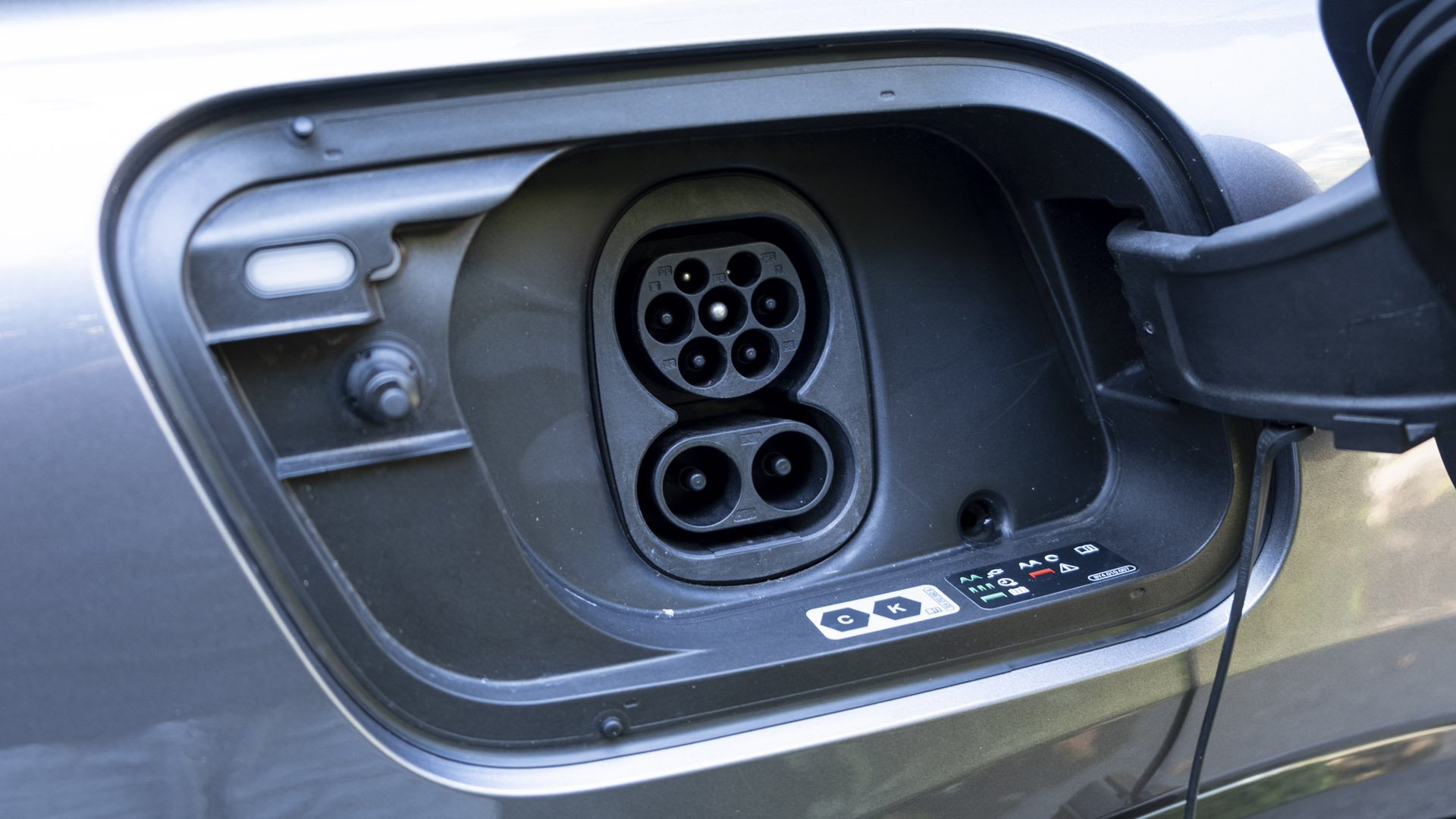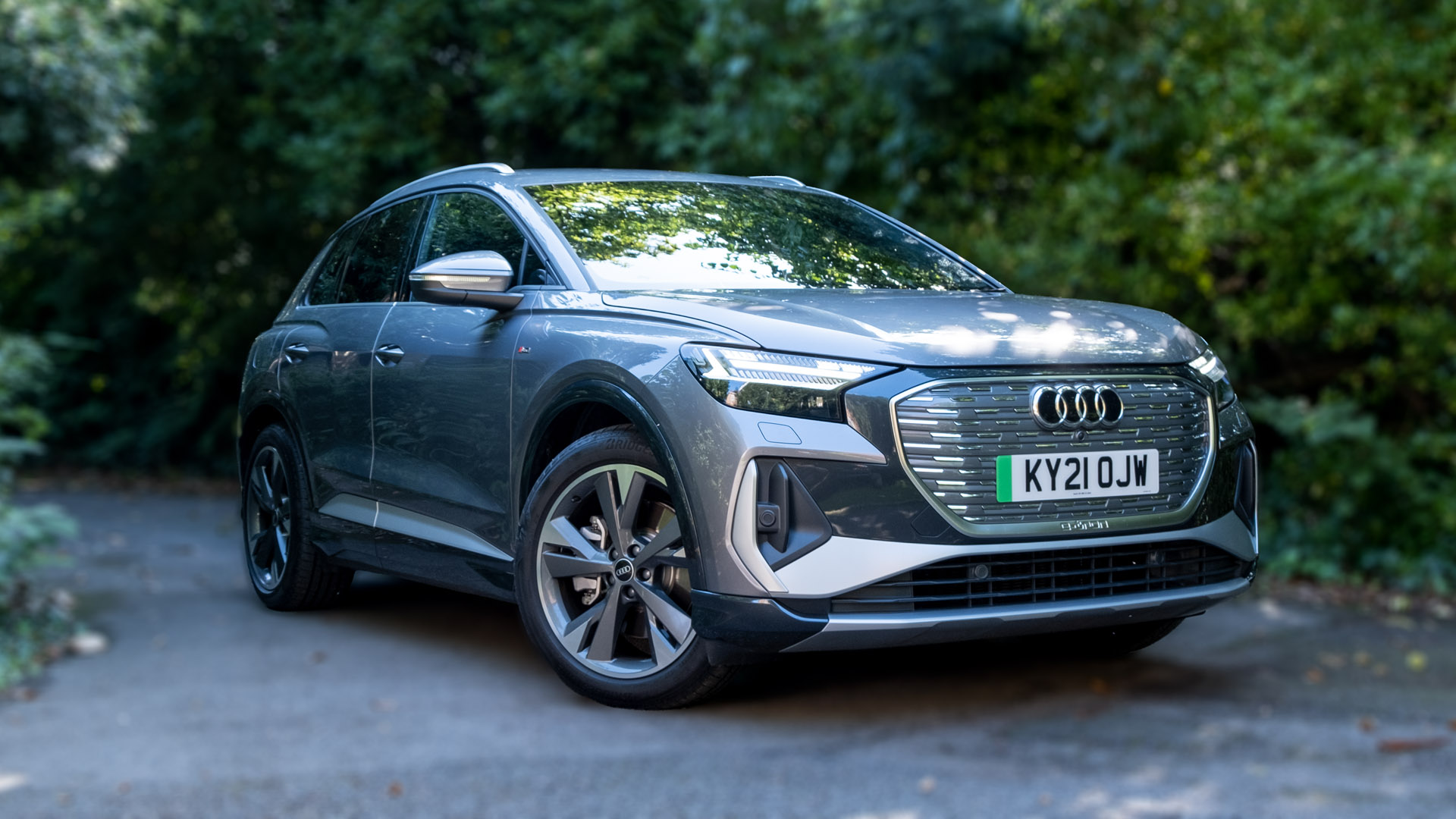The Q4 e-tron is Audi’s second fully electric SUV – it’s the smaller, more affordable sibling of the 2019 e-tron. The German automaker anticipates the Q4 to be one of its best sellers; but in a highly competitive space from its rivals and within the Volkswagen Group itself, can the premium SUV stand out?
We’ll be concentrating on the Q4 40 e-tron that houses the larger 82 kWh battery pack. To be specific, we have the fully loaded Edition 1 on review.
If you’d prefer to watch a review of the Audi Q4 e-tron, head on over to our YouTube channel.
Audi Q4 e-tron price & competition
At the time of writing, there are two battery pack sizes to choose from, 77/82 kWh (Net/Gross) and 52/55 kWh (Net/Gross). The latter is solely available in the 35 model line, while the former is in the 40 and 50 lines. All three models are sold in four trim configurations: Sport, S line, Edition 1, and Vorsprung.
Unsurprisingly, the price of the Q4 e-tron raises as you go up the ladder. In its cheapest 35 configuration, the electric SUV can be found for £40,750; the larger battery pack variant, the 40 e-tron Sport, starts from £44,990, while the dual-motor 50 model starts from £51,370.
Find the best Audi Q4 e-tron deals
To help you breakdown the different trim levels and the standard features that are offered in each, see the images below (click to expand):
When it comes to our recommended options on non-fully-loaded models, we’d opt for the £285 flat top and bottomed steering wheel, £325 Function Package, £575 metallic finish, £650 Safety Package Plus, £950 Heat Pump, and £950 suspension with damper control, and £1,295 Comfort and Sound Pack; this adds £5,030 worth of extras, which on the Sport 40 e-tron takes us to a recommended on-the-road (ROTR) price of £50,020.
As for its competition, there are a few premium all-electric SUVs to consider: the Mercedes EQA from £44,495 (263 miles WLTP); the Volvo XC40 Recharge Twin at £49,950 (259 miles WLTP); the BMW iX3 from £59,730 (285 miles WLTP); the larger Audi e-tron at £62,025 (227-271 miles WLTP); the Jaguar I-Pace at £65,245 (292 miles WLTP); the Mercedes EQC at £65,720 (255 miles WLTP); and the Tesla Model X at £102,980 (348 miles WLTP).
Elsewhere, there are these SUVs to also consider: the MG ZS EV starts from £28,495 (273 miles WLTP); the Kia Soul EV, e-Niro ‘2 64’ and the Hyundai Kona Electric Premium 64 kWh (282 miles WLTP) all come in at £32,445. The Skoda Enyaq iV 60 (256 miles WLTP) starts from £32,010, while the larger battery variant, the Enyaq iV 80 (331 miles WLTP) starts from £39,365. Likewise, the Volkswagen ID.4 has a similar configuration to that of the Skoda, with the 52 kWh battery pack model (213 miles WLTP) coming in at £32,495, and the 77 kWh variant (310 miles WLTP) starting from £42,020.
There is also the Citroen e-C4 (217 miles WLTP), which starts from £30,895 and the Peugeot e-2008 from £30,730 (206 miles WLTP); the Mazda MX-30 SE-L Lux that costs £26,715 (124 miles WLTP). You’ve also got the MG5 EV, an all-electric estate with a claimed range of 250 miles WLTP that starts from £26,495.
Read next: Audi e-tron review: Best premium all-electric SUV?
Audi Q4 e-tron exterior review
Given the Q4’s asking price one might expect a premium exterior design and indeed, Audi’s electric SUV looks the part. At the front, you’re treated with a stylish finish, where its large yet fitting grille takes centre stage; given it’s an electric car, it’s covered and has a two-tone finish with the use of chrome inserts. The matrix LED headlights that come fitted as standard on the Edition 1 model, are also aesthetically pleasing; should you not want to opt for the more expensive trim model, they’ll set you back £1,075 – this option also adds dynamic turn indicators and light sequencing.
Speaking of illumination, the taillights are similarly stylish. They extend the width of the vehicle, have beautiful detailing on the side and give the Q4 its unique e-tron look. The rear of the vehicle is faultless, and surprisingly, there are no fake exhaust outlets like you find in other vehicles offered by the German manufacturer. That said, Audi’s designers couldn’t resist adding fake air inlets at the front of the vehicle.
Moving onto its side profile, the Q4 e-tron can very much be differentiated from its larger sibling, whereby it has a more compact design and its front bumper looks cutoff. The SUV’s smaller footprint also gives it a sportier flair – the side skirts are flared, and the wheel arches are painted to accentuate the tyres. When it comes to its alloys, 19” come as standard, but 20″ and 21″ rims are available in the more expensive trim models – pictured are the stylish 20″ x 8.0J (front) 9.0J (rear) 5-Y-spoke alloy wheels, graphite grey with gloss turned finish.
Buy a car phone mount on Amazon (Affiliate)
As for the paint, the Q4 e-tron comes in a solid ‘Pebble Grey’ colour as standard. Should you want a metallic finish, it’ll cost £575; the following are available: Floret Silver, Glacier White, Navarra Blue, Typhoon Grey, Mythos Black, Geyser Blue, with the £950 Aurora Violet completing the line-up.
Read next: Volkswagen ID.4 review: Better than the VW ID.3?
Audi Q4 e-tron interior review
If you find the vehicle’s exterior aesthetics pleasing, its interior will certainly intrigue; the Q4 e-tron has got that premium look and feel, where the upholstery feels luxurious and the design sits in line with other Audi vehicles.
However, unlike most of the automaker’s interiors, this vehicle has physical and touch-based controls on its steering wheel. This might not come as a surprise, as many new vehicles from the Volkswagen Group opt for such inputs – and we don’t find them particularly intuitive. With the Q4 e-tron, its inputs can sometimes be accidentally actuated when the wheel is held at a certain angle; at times, we’d get a track change (utmost right side in the UK) or a new instrument cluster display (left side in the UK), without meaning to do so. Frankly, it’s a shame that Audi has chosen to follow its Volkswagen counterparts, the ID.3 and ID.4, rather than sticking with a more traditional approach of physical buttons that can be found in the likes of the original e-tron, the e-tron GT and the Skoda Enyaq iV.
Another annoyance is the placement of the electric gear selector and a few physical buttons; Audi has chosen to place these on an over-hanging centre console unit, which we find is not within comfortable reach. Nevertheless, here you’ll find a start/stop button, the drive mode selector, hazard and traction control buttons. There’s also a handy touch-sensitive and clickable pad that’s used to control media playback and volume. Moving your finger on the pad in a circular fashion will adjust the volume – similar to that of an iPod Classic – and press the buttons to back, forwards, mute or switch off the infotainment system; it’s very intuitive.
When it comes to technology, the display is slightly angled towards the driver, which makes for easier interactions with the 10.1″ screen; it’s available in certain countries as an 11.6″ option, too. The infotainment system is both responsive and vivid, where the menu system is easy to navigate. Better still, it also integrates with Android Auto and Apple CarPlay both over a wireless and wired connection. The latter is preferred for superior audio quality, where two USB Type-C ports found underneath the hanging centre console unit provide a connection to the car’s system.
On the subject of audio fidelity, the Q4 e-tron houses eight speakers that output 180 Watts as standard. Opt for the £1,295 Comfort and Sound pack and you’ll get a host of useful features, such as a reversing camera and adaptive cruise control and a ten-speaker Sonos system that outputs 580 Watts. If you’d like to hear how the Sonos system performs, watch our detailed review on YouTube.
Be it if you opt for the audio upgrade or the stock configuration, the media controls are plentiful; where they can be accessed through the infotainment system, via the centre touch-based wheel and through the physical-turn-touch based buttons found on the steering wheel. Speaking of which, for an additional £285, you can get a flat and top bottomed steering wheel that we feel adds to the driver’s feel, as it’s more compact.
Behind the wheel, you’ll find a set of flappy paddles, which adjust the level of regenerative braking. Past that you’ve got the fully digitalized 10.25″ instrument cluster that can be customised to a certain degree; like other Audi vehicles, its interface is excellent. Now should you want to bolster the driving experience, you can have an augmented reality (AR) head-up display – it’s part of the £1,200 Technology pack, which also includes a few other features. Audi’s clever integration of AR shows useful information while on the road. For example, it will indicate when you’re veering off-piste through the use of virtual lines that appear on your display – you can see it in action by watching our short YouTube video, Instagram Reels or TikTok.
Audi Q4 e-tron storage review
When it comes to storage within the cabin, the Q4 e-tron offers an ample amount of space. By the two front USB Type-C ports and 12V socket, you’ll find a non-slip bay for a wallet or small-sized purse, and a wireless Qi-certified smartphone cradle. Further down the centre console, there are two cupholder spaces and the centre armrest compartment, which is large enough for small valuables.
Should you want to take larger items, there is the glove box and the compartment areas within each of the four doors; thanks to smart design, the front ones are large enough for two 500ml bottles – one can be placed under the handle, while another in the door bin.
It’s similarly impressive in boot capacity, where there’s 520 litres with the seats up and 1,490 litres with them folded flat. Put it into perspective, here’s how it stacks up to its all-electric rivals: the original Audi e-tron (660/1,725 litres); Skoda Enyaq iV (585/1,710 litres); VW ID.4 (543/1,575 litres); BMW iX3 (520/1,560 litres); Kia e-Niro (451/1,405 litres); Peugeot e-2008 (434/1,467 litres); MG ZS EV (448/1,375 litres); Volvo XC40 Recharge Twin Pro (452/1,328 litres); Kia Soul EV (315/1,339 litres); Mercedes EQA (340/1,320 litres); Citroen e-C4 (380/1,250 litres); Mazda MX-30 (341/1,146 litres); Hyundai Kona Electric (332/1,114 litres). As for the MG5 EV estate, it offers 464 and 1,456 litres, respectively.
The electronically operated boot is also extremely well-designed. For starters, the seats fold flat making it easy to transport elongated goods. Should you want to have rear occupants, the Q4 e-tron comes, as standard, with a 60:40 rear-split – 40:20:40 split-folding seats feature in the Edition 1 or within the £1,750 ‘Interior package for Front Sport seats in Twin leather’ package.
Aside from the seats, the rear boot has fixing points, hooks, side storage and even a large underfloor compartment which easily accommodates charging cables or other goods. If you want to bolster the rear boot, consider getting the £325 ‘Function Package’, which adds a variable loading floor including a luggage compartment cover, a removable luggage compartment net, storage nets at the back of the front seats, clamp elements in the front cup holders, a lockable glove compartment, and 12V socket in the boot.
Read next: Kia e-Niro review: The best all-electric SUV?
Audi Q4 e-tron comfort review
Transitioning to comfort and here, the Q4 e-tron provides 6-foot 4-inches (193cm) individuals with plenty of legroom and headroom both at the front and rear of the cabin. As for the seats themselves, they’re soft and provide excellent upper- and rear-back support. To better the experience, Audi has included heated front seats with 4-way electric lumbar support. It is, however, disappointing not to see fully electronically adjustable seats come as standard. Should you want this, you’ll need to opt for the Edition 1 trim.
Another annoyance comes with the pressure sensor that’s integrated within the driver’s seat. Indeed, much like other vehicles from the Volkswagen Group, the vehicle powers on when the driver is sat down, whereby pressing down on the foot brake turns on the ignition.
Now while this might seem intuitive for single occupants, once there are others inside the cabin, some might find it inconvenient; each time the driver steps out of the vehicle, the infotainment and climate controls power down. Should a passenger want these comforts, they’ll need to reach over to the physical on/off button placed on the centre console. Granted, this isn’t an issue if you’re sat at the front, but problematic if sat in either of the vehicle’s three rear seats.
On that note, if the rear middle seat isn’t in use, it can be brought down to reveal an armrest that contains two cupholders. When it comes to convenience, there are climate controls at the rear, but the pictured 12V socket and two Type-C ports are only available if you pick the Edition 1 or £1,200 Technology Pack; a steep asking price if you want a simple means of charging electronics at the back of the cabin.
As for cabin noise, Audi does a good job at blocking out environmental noise. Our tested model had the acoustic glazing option fitted, but nevertheless still suffered from a little road noise, and at times, we could also hear wind deflecting off the A-pillars. You can find a bit more information on the subject by reading our dedicated audio review. Suffice to say, it’s not as serene as the Honda e, the Audi A8 or the larger Audi e-tron SUV.
Read next: Tesla Model 3 review (2021 facelift): Should you buy into the hype?
Audi Q4 e-tron performance review
On the subject of comfort, this leads us to the vehicle’s suspension setup. Being a sportier SUV over its Volkwagen siblings, it’s no surprise to learn that the Q4 e-tron has a slightly stiffened configuration. Indeed, when pottering around town you’ll notice the road below, where potholes and speed bumps are felt; it’s not got the floaty air suspension of its bigger e-tron sibling, but you can better the Q4’s riding comfort by adding the ‘adaptive shock absorbers with electronic damper control’ option for £950 or £725 on the Sport and S line/Edition 1 models, respectively; it comes fitted as standard in the Vorsprung trim.
Note, the regular Q4 e-tron comes with ‘Comfort suspension’, while the S line and Edition 1 have the ‘sport suspension with dynamic spring rates and damper settings, 15mm lower ride height’. The latter system was evaluated.
On the plus side, its stock setup does have its advantages on windy country roads. Here, the Q4 e-tron has minimal body roll for a vehicle of its class. This gives you, the driver, confidence when cornering at higher speeds or indeed if you want a bettered driver’s feel. Here, when lobbed in Dynamic mode through the infotainment system, the car has a responsive steering input – we’d say it’s on-par with the equally excellent Volvo XC40 Recharge Twin Pro, but not as impressive as the BMW iX3.
Find the best Audi Q4 e-tron deals
However, the Q4 e-tron, much like its BMW rival, operates on a rear-wheel-drive system in the 35 and 40 line variants. To get an all-wheel-drive setup, as you’d find on the Volvo XC40 Recharge Twin, you’ll need to splash out on the 50 line. This, in turn, means the Audi in its standard configuration can’t compete with the traction levels of the Volvo; you might not want to take it off-road, either.
Similarly, when it comes to performance, the Audi is no match to Volvo’s dual-motor configuration. Here, the 40 line has a single rear-mounted motor that outputs 150 kW (201hp) of power and 310 Nm of torque. The 35 line has 125 kW (168hp) of power and the same torque figure, while the 50 line that has a motor fitted on each axle outputs 220 kW (295hp) and 460 Nm of torque. By comparison, the XC40 Recharge Twin has 304 kW (408hp) of power and generates 660 Nm of torque from its two motors, where it’ll get to 60mph in a tested 4.51 seconds. We had the Q4 40 e-tron tested using Racelogic’s Vbox Sport at 7.67 seconds. As for top speed, the Q4 reaches 99mph in the 35 and 40 line and gets up to 111mph in the 50 line – a tad disappointing for those who frequent unrestricted roads, such as the German Autobahn.
Now while the Q4 e-tron’s raw performance can’t match that of the Volvo, its range does edge its rival. Here, the 82 kWh (77 kWh net) model on review with no heat pump installed, attained 260 miles on a single charge from our mixed driving tests. By comparison, the Volvo achieves 240-250 miles, the Mercedes EQA 210-220 miles, while the older generation e-tron 190-200 miles. To put it into perspective, the Q4 is up there with some of the longest range EVs, where it achieves the same figure as the Kia e-Niro, the Kia Soul EV, the Hyundai Kona Electric, and the Volkswagen ID.4. The Skoda Enyaq iV, on the other hand, gets closer to the 300-mile mark, with the Tesla Model 3 still reigning supreme at 310 miles.
If you live in a country that has a cooler climate, we’d highly suggest getting the £950 Heat Pump option, which we’ve found pivotal in attaining a better range. If the Q4 e-tron on review had one fitted, we wouldn’t be surprised if we surpassed the 300-mile mark; similarly, the VW ID.4 and the Skoda could have attained 300 and 330 miles, respectively.
When it comes to recouping energy back into the battery pack, Audi offers four modes: B-mode, which is initiated by shifting down on the gear selector, and one of the three lighter regenerative braking modes on offer via the flappy paddles found behind the steering wheel. Similar to other vehicles from the Volkswagen Group, the Q4 e-tron can’t come to a complete stop, and instead continues to roll at around 4mph when you lift off the accelerator pedal. Thus, you’ll still need to use the brake pedal within inner-city commutes.
Elsewhere, the recuperation modes need to be initiated each time you step inside the cabin – a rather cumbersome experience if you like to regularly drive in one of the aforementioned modes. Here, the Hyundai Kona Electric, Kia e-Niro, Kia Soul EV, Volvo XC40 Recharge Twin, Polestar 2, and Tesla Model 3 all retain your last-used mode.
To recharge the vehicle at a more rapid rate, Audi supports up to a 125 kW input via the CCS charging port. This will take you to 80% charge from empty in 38 minutes, while using a 50 kW charger will take around an hour. Opt for a 7.2 kW input via the Type 2 port and it’ll take 11hs 30mins from 0-100%, and an 11 kW charge point will take 7hrs 30mins.
It’s worth pointing out that the 11 kW onboard charger (OBC) and the rapid 125 kW DC input is only available in the larger battery pack variants of the Q4 e-tron. The smaller 55 kWh (52 kWh net) model has a 7.2 kW OBC and supports up to 100 kW, only.
Read next: Volvo XC40 Recharge Twin review: A powerful luxury electric SUV
Audi Q4 e-tron safety review
When it comes to safety, the Audi scored 5/5 stars in Euro NCAP’s rigorous crash tests; it managed 93% and 89% in the Adult and Child Occupancy tests, respectively. As for its safety systems, as standard Audi provides cruise control, lane departure warning, rear parking sensors, Audi Pre-sense front with pedestrian and cyclist detection, camera-based traffic sign recognition, and swerve and turn assist.
It’s a shame that certain features don’t come as standard; such as the reversing camera, front parking sensors, a blind-spot monitoring system with exit warning and the adaptive cruise control. Instead, you’ll need to get the Vorsprung version or splash out on the £1,295 Comfort and Sound pack and £650 on the Safety Pack Plus.
Should you want the fantastic augmented reality HUD, you’ll need to spend an additional £1,200 on the Technology pack, too. On the plus side, visibility is excellent throughout the cabin, where Audi has even included a small cut-out by the A-pillars to better the driving experience.
Read next: Hyundai Kona Electric review: Kia e-Niro alternative?
TotallyEV’s verdict on the Audi Q4 e-tron
On the whole, the Q4 e-tron is one of the best electric vehicles Audi has produced. It’s stylish, goes further than the Mercedes EQA, and is comparatively affordable than the likes of the e-tron GT and the larger 2019 e-tron SUV.
Find the best Audi Q4 e-tron deals
However, one should consider the alternatives: if performance in an SUV is at the top of your agenda, consider the Volvo XC40 Recharge Twin instead; if range and a spacious design are, get the Skoda Enyaq iV; and if you don’t mind sacrificing on a bit of space over the Skoda, you should shortlist the more affordable Hyundai Kona Electric, the Kia e-Niro or the funky-looking Kia Soul EV. Out of those, which all-electric SUV would you pick? Let us know in the comments section below or via social media; we’re on: YouTube, Instagram, Facebook, Twitter and LinkedIn.

